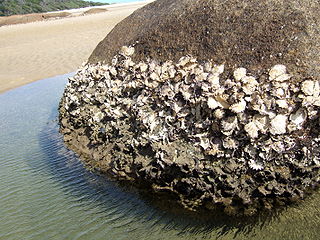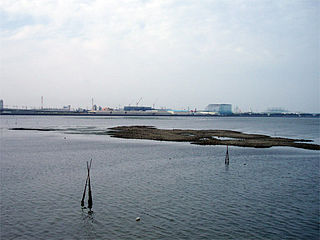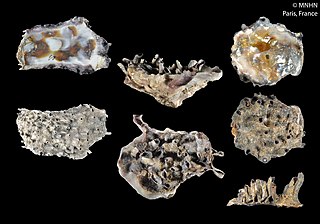
Oyster is the common name for a number of different families of salt-water bivalve molluscs that live in marine or brackish habitats. In some species, the valves are highly calcified, and many are somewhat irregular in shape. Many, but not all oysters are in the superfamily Ostreoidea.

Selective breeding is the process by which humans use animal breeding and plant breeding to selectively develop particular phenotypic traits (characteristics) by choosing which typically animal or plant males and females will sexually reproduce and have offspring together. Domesticated animals are known as breeds, normally bred by a professional breeder, while domesticated plants are known as varieties, cultigens, cultivars, or breeds. Two purebred animals of different breeds produce a crossbreed, and crossbred plants are called hybrids. Flowers, vegetables and fruit-trees may be bred by amateurs and commercial or non-commercial professionals: major crops are usually the provenance of the professionals.

The New Zealand pea crab, Nepinnotheres novaezelandiae, is a small, parasitic crab that lives most commonly inside New Zealand green-lipped mussels. Adult females are about the size and shape of a pea, while adult males are smaller and flatter. Adult New Zealand pea crabs are completely reliant on their host mussel for shelter and food, which it steals from the mussel's gills. The New Zealand pea crab is found throughout New Zealand and can infect up to 70% of natural populations. These crabs are of concern to green-lipped mussel aquaculture because they reduce the size and growth of mussels, although infected mussels can be harvested and consumed.

Crassostrea is a genus of true oysters containing some of the most important oysters used for food. Some species in the genus have been moved to the genus Magallana.

The Ostreidae, the true oysters, include most species of molluscs commonly consumed as oysters. Pearl oysters are not true oysters, and belong to the order Pteriida.

Pinnotheres is a genus of crabs, including the pea crab. Many species formerly in Pinnotheres have been placed in new genera, such as Zaops ostreus, the oyster crab and Nepinnotheres novaezelandiae, the New Zealand pea crab. The species currently recognised in the genus Pinnotheres are:

The Pacific oyster, Japanese oyster, or Miyagi oyster, is an oyster native to the Pacific coast of Asia. It has become an introduced species in North America, Australia, Europe, and New Zealand.

Enchytraeidae is a family of microdrile oligochaetes. They resemble small earthworms and include both terrestrial species known as potworms that live in highly organic terrestrial environments, as well as some that are marine. The peculiar genus Mesenchytraeus is known as "ice worms", as they spend the majority of their lives within glaciers, only rising to the surface at certain points in the summer. Enchytraeidae also includes the Grindal Worm, which is commercially bred as aquarium fish food.

Saccostrea glomerata is an oyster species belonging to the family Ostreidae.

Ostrea is a genus of edible oysters, marine bivalve mollusks in the family Ostreidae, the oysters.

Carditidae is a family of marine bivalve clams of the order Carditida, which was long included in the Venerida. They are the type taxon of the superfamily Carditoidea.

The dredge oyster, Bluff oyster or Chilean oyster, is also known in Chile as ostra verde, is a species of bivalve mollusc in the family Ostreidae.

Michael Alan Rice, is an American professor of fisheries and aquaculture at the University of Rhode Island and former state representative from South Kingstown, Rhode Island. A Democrat, he served in the Rhode Island House of Representatives, representing the 35th district, encompassing the village of Kingston and West Kingston, and parts of the neighborhoods of Tuckertown, Wakefield and Peace Dale. Rice was first elected on November 4, 2008, and served from January 3, 2009, to January 3, 2011.
Haplosporidium is a genus under order Haplosporida.
Marteilia is a protozoan genus of organisms that are parasites of bivalves. It causes QX disease in Sydney rock oysters and Aber disease in European flat oysters. After being infected by Marteilia, bivalves lose pigmentation in their visceral tissue, and become emaciated.

Shintarō Hirase was a Japanese malacologist. His father, Yoichirō Hirase, (1859–1925) was also a malacologist. With his father, he collected shells and helped formalize malacology in Japan. Due to their contributions to malacology, numerous species bear the Hirase name, such as Conus hirasei,.

Neotrypaea californiensis, the Bay ghost shrimp, is a species of ghost shrimp that lives on the Pacific coast of North America. It is a pale animal which grows to a length of 11.5 cm (4.5 in). One claw is bigger than the other, especially in males, and the enlarged claw is thought to have a function in mating. N. californiensis is a deposit feeder that lives in extensive burrow systems, and is responsible for high rates of bioturbation. It adversely affects oyster farms, and its numbers are controlled in some places by the application of pesticides. It carries out an important role in the ecosystem, and is used by fishermen as bait.

Oyster reef restoration refers to the reparation and reconstruction of degraded oyster reefs. Environmental changes, modern fishing practices, over harvesting, water pollution, and other factors, have resulted in damage, disease, and ultimately, a large decline in global population and prevalence of oyster habitats. Aside from ecological importance, oyster farming is an important industry in many regions around the world. Both natural and artificial materials have been used in efforts to increase population and regenerate reefs.

Magallana is a genus of true oysters containing some of the most important oysters used for food. Species in this genus have been moved from Crassostrea after it was found to be paraphyletic.

Saccostrea echinata, commonly known as the tropical black-lip rock oyster, blacklip rock oyster, blacklip oyster, and spiny rock oyster, is one of several tropical rock oyster species, occurring in tropical seas across the Indo-Pacific, including coastal waters across northern Australia to Noumea.















